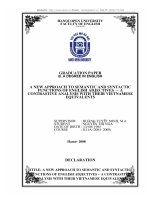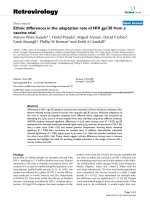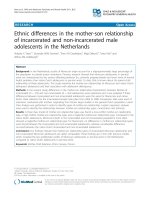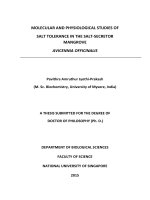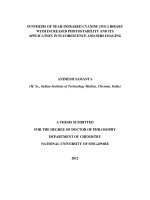Individual and ethnic differences in habitual usage of reappraisal and suppression in relationship with their associated psychological and physiological consequences 2
Bạn đang xem bản rút gọn của tài liệu. Xem và tải ngay bản đầy đủ của tài liệu tại đây (82.95 KB, 8 trang )
!
i!
Acknowledgement
There are many people that I want to thank upon the completion of this dissertation.
I owe my deepest gratitude to my husband and my family, for their bondless understanding
and unconditional support in helping me to pursue my dream.
I would like to express my deep and sincere gratitude to my supervisor, Professor
George Bishop, Ph. D, Head of the Department of Psychology, National University of
Singapore. His wide knowledge, logical ways of thinking, constructive comments, and
important support throughout this work have been of great value for me. This thesis would
not have been possible without his help.
Next, my appreciation and solute goes to A/P Annett Schirmer. who offered me
chances to join her group meeting and allowed me to learn so much from there.
This work is also indebted to many of the members in the department: A/P Mike
Cheung for his advices in statistics; Dr. Why Yong Peng for his technical advices in the lab;
Stephen, Li Neng, Yong Hao, Kanika, and Ranjith for those invaluable discussions.
Last but not least, endless gratitude is owed to my peers who were and are in the
graduate room and the laboratory, for their companion and support. All these technical and
spiritual support I’ve received truly warmed my heart and I am enormously indebted to
everyone who had encouraged me to be here.
!
ii!
Table of Content
!
Summary
v
List of Tables
vii
List of Figures
viii
CHAPTER 1
Introduction
Process Model of Emotion Regulation
1
Two Specific Strategies: Cognitive Reappraisal and Expression Suppression
3
Two Specific Health Indicators: Subjective Well-being and Cardiovascular
Reactivity
4
Affective and Physiological Consequences of Reappraisal and Suppression
7
Moderation Effect of Culture between Emotion Regulation and Consequences
8
Individual and Group Differences in Usage of Reappraisal and Suppression
9
Culture Shapes the Relationship between Emotion Regulation Strategies and
Consequences
11
Chinese and Indians
12
Overview of the Present Research
14
CHAPTER II
Study 1 – Emotion Reappraisal and Suppression, and Their Relationship with
Subjective Well-being among Chinese and Indians
Overview
17
Objectives and Hypotheses
20
Method
22
Participants
22
Measures
22
Results
24
Preliminary Analyses
24
Structure of ERQ Scale
24
SWB Scales
25
Intercorrelations among Variables
26
Hypotheses Testing
27
Group Differences of ERQ Subscales
27
Emotion Expression in front of Different Audiences
27
Relationship between Ethnicity, Emotion Regulation, and SWB
29
Discussion
30
Ethnic Difference in Reappraisal Usage and Its Association with SWB
30
Emotion Expression in Chinese and Indians
33
Consequence of Suppression among Asian Population
35
!
iii!
CHAPTER III
Study 2 – Individual and Ethnic Differences in Habitual Usage of Reappraisal and
Suppression in Relationship with Cardiovascular Profile
Overview
37
Objectives and Hypothesis
44
Method
45
Participants
45
Design
47
Tasks
47
Procedure
48
Measures
49
Data Analysis
52
Data Reduction of Physiological Indices
52
Manipulation Check
52
Results
53
Descriptive Statistics
53
Hypothesis Testing
54
Usage of Reappraisal and Suppression
54
Self-reported Emotional Experience
55
Effects of Emotion Regulation, Ethnicity, and Condition Manipulation
on CVR
58
Other Findings
61
Discussion
62
Patterns of CVR Responses
62
Patterns of Self-rated Emotional Experiences
62
Self-reported Usage of Emotion Regulation Strategies
63
Non-significant Correlation between Suppression and DVs
65
Positive Association of Reappraisal with Emotional and Cardiovascular
Reactivity
67
CHAPTER IV
Study 3a – Individual and Ethnic Differences in the Usage of Reappraisal and Its
Relationship with Subjective Well-being
Overview
69
Objectives and Hypotheses
71
Method
72
Participants and Procedure
72
Measures
73
Results
75
Preliminary Analyses: Overview of Variables
75
Hypotheses Testing
75
Reappraisal Usage in Different Ethnic Groups
75
Reappraisal Dimensions in Relationship with SWB
77
Discussion
79
Culture and General Usage of Reappraisal
79
The Implications of Reappraisal Dimensions
79
!
iv!
Study 3b – Individual and Ethnic Difference in Emotion Expression and
Suppression in Different Situations
Overview
82
Objectives and Hypotheses
85
Method
86
Results
88
Preliminary Analysis: Descriptive Statistics
88
Hypothesis Testing
88
Group Differences in ERQ.S
88
Cross-situational Variation of Emotion Expression among Ethnic
Groups
90
Other Findings
92
Discussion
93
Cross-situational Variation: The Manifestation of Cultural Display Rules
93
Ethnic Difference in Emotion Expression
94
Limitations
95
CHAPTER V
General Discussion
Summary of Findings
98
Contribution: Process Model in a Socio-cultural Functional View
100
Cultural Models of Emotions: Chinese and Indians
104
Non-conscious Forms of Emotion Regulation and Socio-cultural Influence
107
Automaticity Hypothesis
109
Limitations and Implications for Future Directions
111
Conclusion
113
REFERENCES
114
APPENDIX A
124
APPENDIX B
127
APPENDIX C
128
APPENDIX D
129
!
!
v!
Summary
The effects of two emotion regulation strategies, reappraisal and suppression, on
subjective well-being (SWB) and cardiovascular reactivity (CVR), and the potential
moderating role of ethnicity on these relationships were investigated. Results showed
reappraisal to be an adaptive emotion regulation strategy, linked positively to SWB, and to
more adaptive affective and physiological reactivity in response to an anger provocation. This
positive relationship holds for both genders and among Chinese and Indians. On the other
hand, usage of suppression showed no correlation with SWB or cardiovascular reactivity
during anger provocation in our Asian samples. This non-significant relationship is consistent
with the claim of “automaticity hypothesis”, such that Asians use suppression often and
become good at it, and therefore suppression usage is associated with ameliorated
consequences. In addition, Chinese and Indians showed differences in their reappraisal and
expression of emotions, which reflects socio-cultural influences on cognition and behavior.
Three studies were conducted. Study 1 is a survey study. One hundred and six
Chinese and Indians took part in this study. A positive relationship between reappraisal usage
and SWB emerged, but the relationship between suppression usage and SWB was not
significant in our sample. Chinese and Indians also reported different emotion expression
patterns in front of different audiences.
Study 2 is a laboratory-based study. Forty Chinese females and forty-one Indian
females were involved in this experiment. Higher reappraisal scores are associated with
healthier CVR profile and higher positive emotion ratings during a stress-eliciting task. In
contrast, suppression usage had no significant association with CVR or self-reported affective
experience during the experiment.
Study 3 is another survey study. Two hundreds and thirty-two Chinese, Indians, and
Caucasian completed the questionnaires. The positive relationship between reappraisal usage
and SWB was replicated. In addition, using reappraisal to sustain negative affect and dampen
positive affect was proved to be independent predictors on SWB. Emotion expression levels
!
vi!
in different situations were also studied. Caucasians reported overall higher expression and
lower suppression than Chinese and Indians in various situations. Indians reported higher
direct expression of dissatisfaction and appreciation than did Chinese, especially to people
who are not emotionally close.
Overall, the three studies investigated individual and group differences of
reappraisal and suppression usage, as well as their relationship with affective and
physiological consequences. These results support the usefulness of the process model of
emotion regulation in studying different regulatory strategies, but emphasize the need to
adopt a socio-cultural perspective.
!
vii!
List of Tables
!
!
Table 1
Means and SD of SWB Scales by Ethnicity
26
Table 2
Pearson Correlations among Variables
26
Table 3
Repeated Measure MANOVA on Expression In Front Of
Different Audiences
28
Table 4
Means and (SD) of Emotion Expression in front of Different
Audiences
28
Table 5
Effect of Close vs. Not-close Relationship on Emotion
Expression By Ethnicity
29
Table 6
Means and (SD) of Demographic Information by Ethnicity
46
Table 7
Means and (SDs) of CVR by Ethnicity and Condition
54
Table 8
Means and (SD) of Self-reported Reappraisal and
Suppression Usage
55
Table 9
Effects of ERQ.R, Ethnicity, and Condition on Self-rated
Emotional Experiences
57
Table 10
Means and (SD) of Self-rated Irritation Composite Scores by
Ethnicity and Condition and Time
57
Table 11
Effects of Covariates, Baseline, Reappraisal, Ethnicity, and
Condition on CVR
59
Table 12
Means and (SD) of Self-rated Positive Composite Scores by
Ethnicity and Condition and Time
61
Table 13
Means for Demographic Variables by Gender and Ethnicity
73
Table 14
Means and SD of the Variables, along with Scale Properties
76
Table 15
Pearson Correlation among Variables
77
Table 16
Hierarchical Regression Analyses Predicting SWB From
Reappraisal Scores
78
Table 17
Items for Emotion Expression Assessment Inventory
86
Table 18
Scale Properties, Means and SDs for the EEAI and ERQ.S
89
Table 19
Repeated-measure MANOVA on Eight Dimensions of The
EEAI
90
Table 20
Marginal Means for AE in Different Situations by Ethnicity
91
Table 21
Marginal Means for CE in Different Situations by Ethnicity
92
Table 22
Marginal Means for CE in Different Situations by Gender
92
Table 23
Pearson Correlations Between ERQ.S Score and Well-Being
Scales
109
!
!
viii!
List of Figures
!
Figure 1
Process Model of Emotion Regulation (from Gross & John, 2003)
3
Figure 2
Emotion Expression Ratings by Relationship and Ethnicity
29
Figure 3
Significant Coefficients of ERQ.R on CVR Readings
60
!
!
